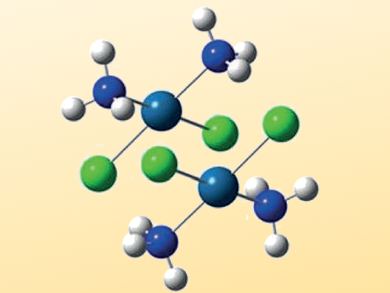The development of computational chemistry during the past decades has had a large impact in all areas of chemistry. However, it is often overlooked that a meaningful comparison with experimental results requires a model that reflects the correct physical situation.
One example for this problem are the structural and vibrational properties of cisplatin, cis-[Pt(NH3)2Cl2], for which the correct simulation of the experimental results still remains a challenge. Despite the use of state-of-the-art approaches, the agreement between theoretical and experimental results has still not been satisfactory.
Vincenzo Barone, Scuola Normale Superiore, Pisa, Italy, and colleagues have extended the cisplatin model from the molecular system to a dimer (pictured). The dimer model includes stacking interactions that are ignored when using the monomer, and thus allows the calculation of values that are in agreement with experimental data.
The general outcome of this study is that benchmarking against experimental data is instrumental for the development of computational approaches, which must be based on a correct physical model in order to avoid misleading results, for example, in drug design.
- Correct Modeling of Cisplatin: a Paradigmatic Case,
Nicola Tasinato, Cristina Puzzarini, Vincenzo Barone,
Angew. Chem. Int. Ed. 2017.
DOI: 10.1002/anie.201707683




